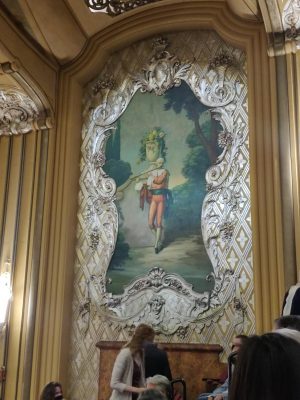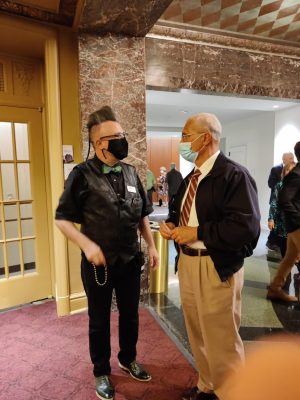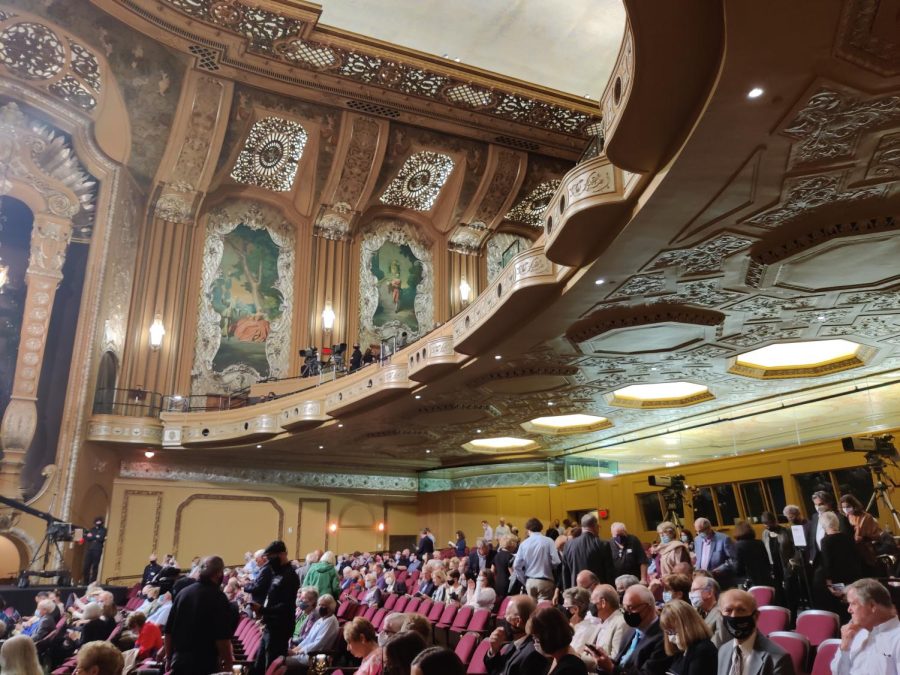MSO returns to in-person performances
Audience members find their seats in the historic Warner Grand Theater. The Milwaukee Symphony Orchestra performs in the newly reopened hall.
For the first time in nearly a year and a half, the Milwaukee Symphony Orchestra (MSO) welcomed the public to an in-person symphony performance, A Grand Opening. Performances took place from October 1 through 3 in their new concert hall, the Bradley Symphony Center on Wisconsin Ave. Broadcast by Milwaukee PBS on Saturday evening, the symphony hoped to engage audiences around Milwaukee with a set that featured modern works and jazz music reminiscent of the building’s former days as the Warner Grand Theater.
The set opened with the world premiere of Eric Nathan’s piece, Opening. The eight-minute piece juxtaposes stillness and activity, according to Nathan’s program notes. His piece is unique because the solo flute, oboe, clarinet, horns, trumpet and violins perform within and behind the audience instead of on-stage. Further, string players occasionally play their parts not together, giving what Nathan believes is an illusion that “they are soloists within a larger collective, creating a communal sense of singing.” According to Nathan, he was originally invited to compose the opening piece for the 2020-2021 symphony season until that season was cancelled due to the COVID-19 pandemic. Nathan understood that his piece would serve as a welcome back to both a new symphony hall and live performances for many audience members and players. Nathan was present at the Saturday concert to receive the applause of attendees and hear his piece in performance.
The second piece of the set was another modern composition. In its North American premiere, the MSO string section performed James B. Wilson’s Green Fuse. Inspired by a Dylan Thomas poem, the piece leaves the audience questioning the intent of the composition.
The next two pieces featured pianist Aaron Diehl. Diehl recently performed with the New York Philharmonic, and has a Bachelors of Music in jazz studies from Julliard. According to program notes, Diehl “conjures three-dimensional expansion of melody, counterpoint, and movement through time.”
In the final piece before the intermission, the MSO performed George Gershwin’s Rhapsody in Blue. The lighting above the stage turned blue in a nod to the name of the piece. Gershwin’s composition combines both jazz and classical musical techniques to delight listeners with the best of both worlds. Beginning with Todd Levy’s exceptional clarinet solo, the piece highlighted expressive playing from the woodwind and brass sections. Diehl’s piano solos and improvisations abilities captured the audience, and he seamlessly switched between each of the counter-melodies in the piece. At the end, the audience gave Diehl and the symphony a well-deserved standing ovation.
After intermission, the ensemble returned with New World A-Comin’, a piano concerto composed by prolific jazz composer and musician Duke Ellington. With a very complex piano part, Diehl once again demonstrated his musical ability.
The final piece the symphony performed was Igor Stravinsky’s Suite from The Firebird. Originally composed in 1909-10 for a ballet based on the Russian story of Firebird, the symphony performed the 1919 version that was altered by reducing instrumentation. The five-movement piece is characterized by Russian dances, intricate rhythms, harmonic glissandos and a distinctive horn solo in the Finale. This piece also earned a standing ovation from the audience.

With a performance selection based around modern compositions, American classics from the 20th century jazz scene and Stravisnky’s 20th century ballet, the symphony captured themes that were appropriate for their new building. Formerly the Warner Grand Theater, the building originally opened in 1931 and was one of the last theaters built in Milwaukee before the Great Depression ended a boom of theater building across the country. It was previously owned by Marcus Theaters, who separated the main stage into two seperate movie theaters. However, the building has been unoccupied since 1995.
The MSO kept original aspects of the French Renaissance theater and Art Deco lobby, in addition to adding a new and modern lobby. The only change made to the original Art Deco lobby was updated light fixtures. The exit signs around the building are historic signs from the building’s days as a movie theater and the Warner Theater sign is restored outside. The modern lobby has several nods to the world of music. The tiles on the first floor are black and the second floor are white, symbolizing piano keys. The wood paneling on the side of the room represents violin wood. The spiral staircase in the center of the room looks like a harp, and the room is complete with brass accents representing the brass instruments. Another interesting aspect of the new lobby is the names of composers etched in gold inside the glass walls.
The interior of the theater is also grand. Along the walls there are beautiful paintings by Louis Grell. Notable paintings include a man playing the flute or piccolo and a woman being pushed on a swing. The stage itself is large and high and has acoustical paneling at the top and seats for Milwaukee Symphony Orchestra Chorus members. During moments of climax in the performance, lights near the top of the stage were turned on and faced the audience.

In 2001, the MSO conducted acoustical testing of the theater, but it wasn’t until 2018 that construction officially started. The MSO decided to purchase the building because the organization felt that it was large enough to have its own hall, separate from Uihlein Hall in the Marcus Center for Performing Arts. The MSO shared that hall with several groups including the ballet, Broadway, opera and other musical and artistic groups. Having their own venue gives the MSO the opportunity to generate more revenue sources and have increased flexibility in scheduling the symphony.
As other symphony halls across the country were built out of Rapp & Rapp theaters—the St. Louis Symphony’s home, for example—it made sense to begin construction on the building. Main construction processes included removing a wall that Marcus Theaters used to separate the theater in two and moving a several ton wall on the stage to increase the space necessary for an entire symphony.
The MSO has a packed season planned including a sold out Yo-Yo Ma performance on April 29. Frank Almond, former concertmaster, returns next on the Classics concert performing Bruch’s Violin Concerto on October 15-16. To architecture and music fans alike, an MSO performance presents an exciting opportunity.

